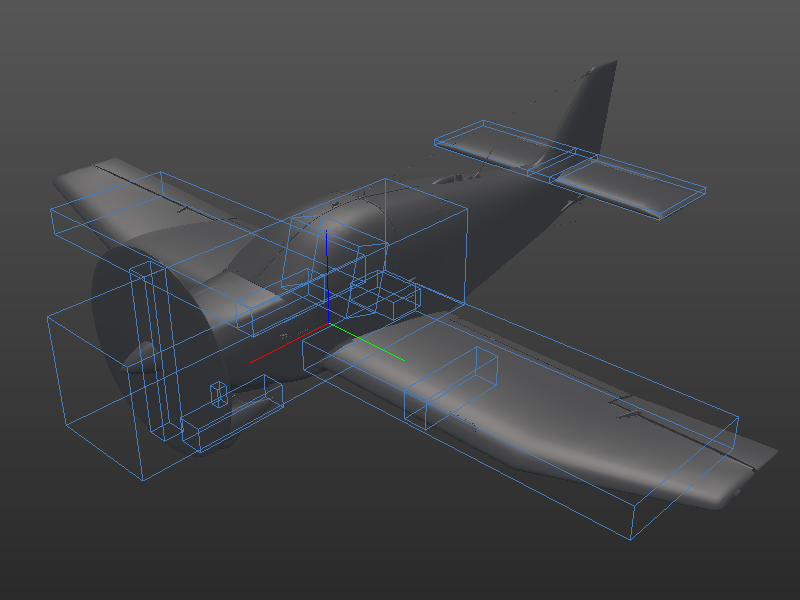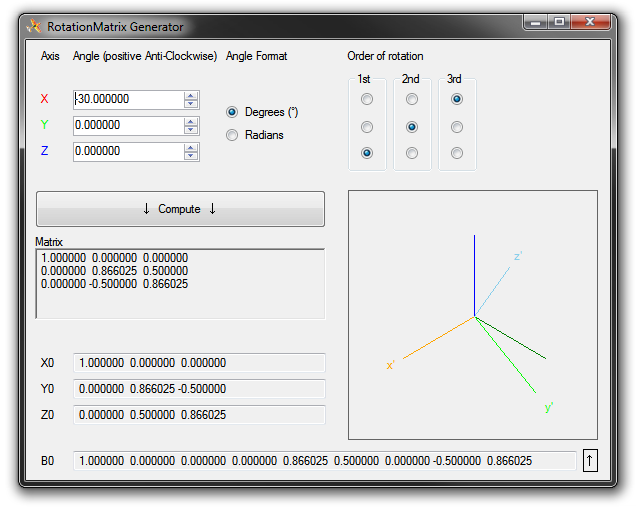This is an old revision of the document!
Table of Contents
Rigidbody-System
The most defining feature of an aircraft's behavior is its mass. Even without any air and without any aerodynamics or propulsion an aircraft would still travel as far as you can throw it. If it weren't for the gravitational pull it would would just keep moving and rotating for as long as there is no external force stopping it. This motion and rotation of a mass object can be represented mathematically which is how a flight simulator like Aerofly is able to calculate the movements of an aircraft.
For this mathematical description Aerofly needs to know a few key parameters of the objects it is simulating. Most important of all is the mass, which is represented in Kilograms. The mass defines how fast an object accelerates when a given force acts onto it. For example: If an aircraft is on the ground and the aerodynamic forces are neglitable then the acceleration of the aircraft is directly proportional to the thrust of the engine divided by the mass of the aircraft. Heavier aircraft with the same thrust will therefor accelerate much slower than light aircraft. And only if the total mass of the aircraft is set to a realistic value will the acceleration be realistic.
Rigidbody
Aerofly uses the mathematical concept of a rigidbody to simulate the aircraft mass. A rigidbody in Aerofly can be thought of as a box with a certain size, a certain mass, position and orientation, velocity and angular velocity (rotation speed). Roughly speaking “a box that moves and rotates”.
We usually break down the aircraft into several parts, for example the left and right wings, the fuselage, stabilizer, propeller and individual parts of the landing gear (those that move independent of each other).
Here is a visualization of how all the rigidbodies of the DR400 aircraft:

In the tmd file the rigidbody of the fuselage is defines like this:
<[rigidbody][Fuselage][]
<[float64][Mass][387.0]>
<[tmvector3d][InertiaLength][ 4.0 1.116 1.08 ]>
<[tmvector3d][R0][ 0.612 0.0 0.396 ]>
<[tmmatrix3d][B0][ 1.0 0.0 0.0 0.0 1.0 0.0 0.0 0.0 1.0 ]>
>
Let us break down each parameter:
Name
The name of the object is defined in the line of code <[rigidbody][Fuselage][]. Here it is set to Fuselage. This identifying name can only be used once and is used throughout the entire file to reference this rigidbody. Anywhere another object in the tmd uses Body or PositionID (or something similar) we can plug in a rigidbody name.
Mass
This is self explanatory. The mass of the rigidbody defines how fast an object accelerates with a given force acting on it. One of these forces could be gravitation. The force that we call weight is just the mass of an object multiplied by the gravitational constant (e.g. on Earth about 9.81 m/s²).
In the line <[float64][Mass][387.0]> we set the mass of the rigidbody to 387 Kilograms.
InertiaLength
With <[tmvector3d][InertiaLength][4.0 1.116 1.08]> we set the size of our rigidbody to 4m long, 1.116m wide and 1.08m high. The greater each of the values the higher the inertia of the object. With a given torque (e.g. torque of the engine) the inertia defines how fast the angular speed (rotation speed) of the object increases, in other words how high the rotational acceleration is. With higher values the rigidbody will resist any attempt of starting or stopping a rotation. This directly affects how agil the aircraft is in the simulation.
R0
R0 is the position of the body at simulation time zero, or if you neglect any movement of the parts then R0 is the position of the rigidbody relative to the aircraft's origin. <[tmvector3d][R0][0.612 0.0 0.396]> sets the center of mass of our rigidbody to 0.612m in front of the origin and 0.396m up. The y component is 0 because the fuselage mass for our symmetric aircraft should be exactly on the symmetry plane.
B0
B0 is a rotation matrix and represents the orientation of the body at simulation time 0, or if you neglect any bending what so ever then this is the orientation of the object relative to the orientation of the aircraft.
Most objects are aligned with the aircraft orientation so we can remove this line or explicitly leave the default value <[tmmatrix3d][B0][ 1.0 0.0 0.0 0.0 1.0 0.0 0.0 0.0 1.0 ]> in.
The B0 matrix is define in columns, in this case:
X = 1.0 0.0 0.0
Y = 0.0 1.0 0.0
Z = 0.0 0.0 1.0
A recommended tool to generate the B0 rotation matrix has been published by one of our team members: Rotation Matrix Generator (use at own risk)
Joints
The individual rigidbodies of the aircraft are each simulated independently and there is no connection between them yet. Joints are used to connect rigidbodies together to create the flexible airframe. A joint can be thought of as a spring and damper system that creates a force and torque when two rigidbodies are moved or rotated relative to each other.
The spring force is the displacement multiplied by the spring constant “K”.
The damping force is the relative velocity times a damping constant “D”.
In the Aerofly FS 2 physics engine we have several joint types to chose from:
- multibody_joint
- jointlinear
- jointtorque
Multibody-Joint
A multibody_joint is a connection between two rigidbodies that allows only one new degree of motion. This means the two objects are coupled together very strongly and will move or rotate pretty much dependent of each other. (not independent!)
This is an example of the left wing's root joint. It is allows a rotation around the x-axis, which means the wing can still flap up and down but it can't freely move forward, left/right or up/down (without rotation) relative to the fuselage or rotate around any other axis. The values Kp and Kd are set quite high, since the wing creates a lot of lift and this joint has to transfer that bending torque around the root.
<[multibody_joint][JointFuselageLeftWing][]
<[string8][Body0][Fuselage]>
<[string8][Body1][LeftWing]>
<[tmvector3d][X0][ 1.0 0.0 0.0 ]>
<[tmvector3d][R0][ -0.27 0.558 0.018 ]>
<[float64][Kp][1000000.0]>
<[float64][Kd][10000.0]>
<[uint32][Type][0]>
>
Type
There are two modes of this joint:
Type 0 allows the two bodies to only rotate relative to each other on one axis.
Type 1 allows the two bodies to move relative to each other along one axis.
X0
X0 is the rotation axis (type 0) or translation axis (type 1) of the joint connection. It is a unit vector.
R0
R0 is the rotation pivot (type 0) or attachment point (type 1) as a position in meters relative to the aircraft origin.
Kp
Spring constant in Newton-Meter per radiant = N*m/rad (type 0) or Newton per meter = N/m (type 1). Higher values mean the connection is stiffer and the torque/force created is much higher at small displacement.
Kd
Damping constant in Newton-Meter per radiant and second = N*m/(rad*s) (type 0) or Newton per meter and second = N/(s*m) (type 1). Higher values mean the connection is damped more and the torque/force created is much higher at small relative velocities.

